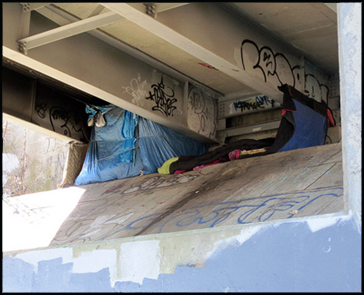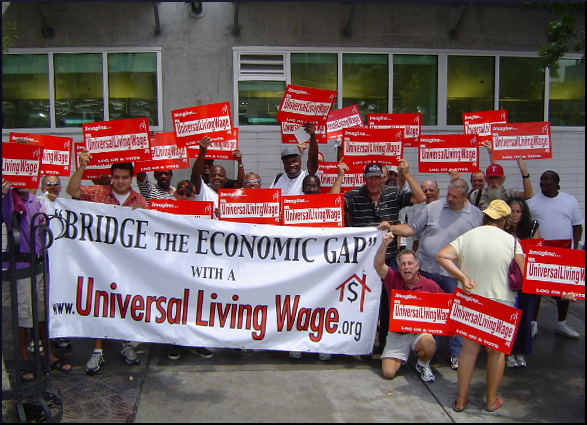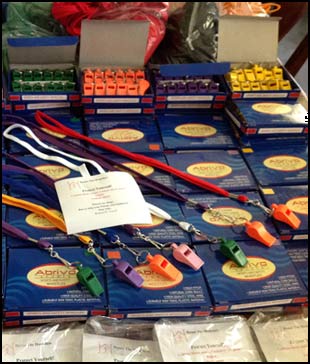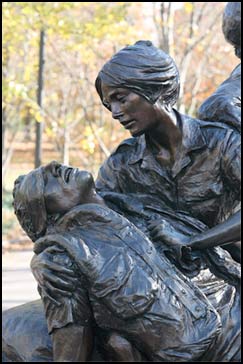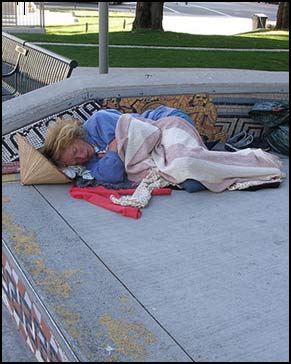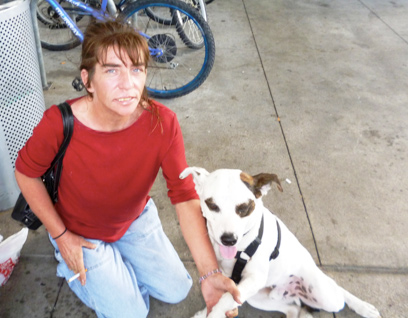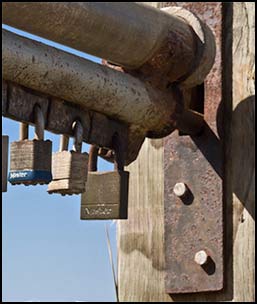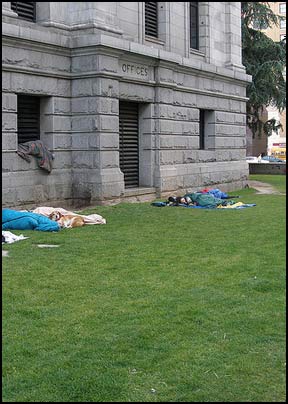
Many citizens and groups give enormous amounts of time and money, and even face the wrath of the law, to make sure that people experiencing homelessness have something to eat, and they deserve all the support they can get. Outside the realm of food, other goods and services are offered to street people by an array of organizations and maverick individuals.
In the Canadian city of Windsor, chiropractor Dean Tapak shows up once a week at the Windsor Essex Community Health Centre and treats low-income clients for free. He is affiliated with the Street Health, a program that provides showers, dental care, and other health-related services to about 4,000 people. Dr. Tapak personally helped more than 200 clients.
The California community of Los Gatos-Monte Sereno annually recognizes the police department’s Crisis Intervention Team, including an Officer of the Year. Last year, that honor went to Leo Coddington, a cop who takes the trouble to learn the names of the town’s homeless residents and figure out how to help them.
Coddington is particularly aware of the needs of homeless veterans, having graduated from West Point and spent 12 years in the army himself. After joining the police force, he took a 40-hour continuing education course in police interaction with vulnerable populations, and became part of the Santa Clara County Collaborative on Housing and Homeless Issues. Journalist Sheila Sanchez interestingly points out that Coddington is a “housing first” kind of guy, who believes the most effective way to help is to get people under a roof first, then address their mental disability, post-traumatic stress disorder, addiction, or alcoholism.
The same attitude of meeting people where they are, without expectations or judgment, is shared by another man who does similar work in Los Angeles and credits the philosophy of TV personality Oprah Winfrey as his inspiration. Unlike the police officer, Troy Eric Isaac is not bankrolled by taxpayers, but by a philanthropist who supplies the funds that Isaac uses to help the homeless.
Journalist Kevin Ferguson describes Isaac is “sort of freelance homeless advocate” who walks around the inner city looking for need and figuring out how to meet it. For one, the answer might be to sit with the person and sing a song. For another, it might be to make phone calls every day checking on the availability of a room with a long waiting list.
There are also philanthropists in the Canadian city of Vancouver where, in this case, the donors allocated $30 million of their fortune to the homeless, under conditions so particular that the local law had to be changed to accommodate them. Namely, if the city could figure out how to put an existing facility back into working order, the anonymous couple’s gift would be structured in such a way as to take care of the annual operating costs without the need for further government support.
The old Taylor Manor was originally built as a home for the elderly, but has not been used for that purpose for at least a decade. The renovation will take about two years and at least $14 million of public funds and corporate donations, and will eventually house 56 (no longer) street people with “complex mental issues.” Reporter Jeff Lee tells us that Vancouver’s homeless population almost doubled in a year, and quotes Prof. Kerry Jang of the University of British Columbia:
Many of our staff have been out there and we see the suffering every single day. And every day I feel hopeless because what can we do? We put [people] into hospital for a while and they are let back out on the street again with no hope. It is just a revolving door, a revolving door, a revolving door.
At St. Colette Church in Livonia, Michigan, a group has a dual-purpose ministry. Mainly, for people experiencing homelessness in Detroit, they crochet or knit sleeping mats to serve as insulation from the cold and damp of the ground. Secondarily, they make the mats from “plarn,” which is plastic yarn made from cut-up retail shopping bags. It takes as many as 700 bags to make each sleeping mat, so that’s a lot of recycling. About 40 parishioners have signed up, of whom about half turn up at any given weekly meeting. Reportedly, a Chicago church has actually published a DVD with full instructions on how to make these mats.
Throughout America, thousands of faith-based groups, from venerable giants like St. Vincent de Paul to the little mat-knitting club, work to help the homeless. Perhaps wanting some favorable press too, a number of Austinites founded their own group with the motto, “Toiletries and more, under the freeway — without the preaching,” and a homepage that misspells “sporadic.” Their website lists the specific items they distribute: toothbrushes and toothpaste, soap, shampoo, TP, hand sanitizer, disposable shavers, socks, gloves, granola, and bottled water.
Water is also distributed by ThirstAid of Maricopa County, Arizona, through a program that has been very successful in the past years. The heat there is brutal, and the water saves lives. Before the end of September, they reckon they will find the money for, and give out, 500,000 bottles of water. Half a million — man, that’s a lot of plastic bottles headed for the landfill, and it raises a question. Could this be done in a greener way? Couldn’t people, instead, be given canteens or camping-style water bottles, and provided with sources of clean drinking water from which to refill them? Just asking.
But, getting back to Austin, the exigency of events made the Emergency Whistle Defense Program one of the most important stories in the Texas capital. The ability to produce a loud distress call empowers a person experiencing homelessness alone in the night, or any time. The program is giving away whistles and teaching the signal — three blasts, and pause before repeating if necessary. The distribution of “thunder whistles” has been covered extensively by local television, including stories by radio stations NPR and KLBJ, News 8-YNN, KEYE-TV, and KVUE-News 24.
They all interviewed House the Homeless President Richard R. Troxell on the value of such noise as a deterrent to violence. Omar Lewis of KXAN-News 36 also interviewed Vincent Godoy, father of Valerie Godoy, murdered in Austin in June. FOX 7 TV‘s Derrick Mitcham said:
According to the Austin Police Department, violent crimes against the homeless population make up 38 percent of all violent crimes downtown.
Nope, it is not too late to sign the new women’s shelter petition!
Reactions?
Source: “Homeless helped by chiropractor,” The Windsor Star, 02/25/12
Source: “Town Cop Recognized for Work With Homeless,” Los Gatos, CA Patch, 03/29/11
Source: “Helping the homeless any way he can,” SCPR.org, 01/13/12
Source: “Anonymous wealthy couple’s $30-million gift to help homeless in Vancouver,” The Vancouver Sun, 06/29/12
Source: “Parishioners make sleeping mats for homeless from plastic bags,” Hometownlife.com, 08/05/12
Source: “Atheists Helping the Homeless,” AtheistsHelpingtheHomeless.org
Source: “ThirstAid: Human Services Campus Water Drive,” Cassaz.org, 06/11/12
Source: “Sounding alarm on violence on homeless,” KXAN.com, 08/06/12
Source: “Advocacy group to help homeless blow whistle on crime,” MyFoxAustin.com, 08/06/12
Image by quinet (Thomas Quine), used under its Creative Commons license.

